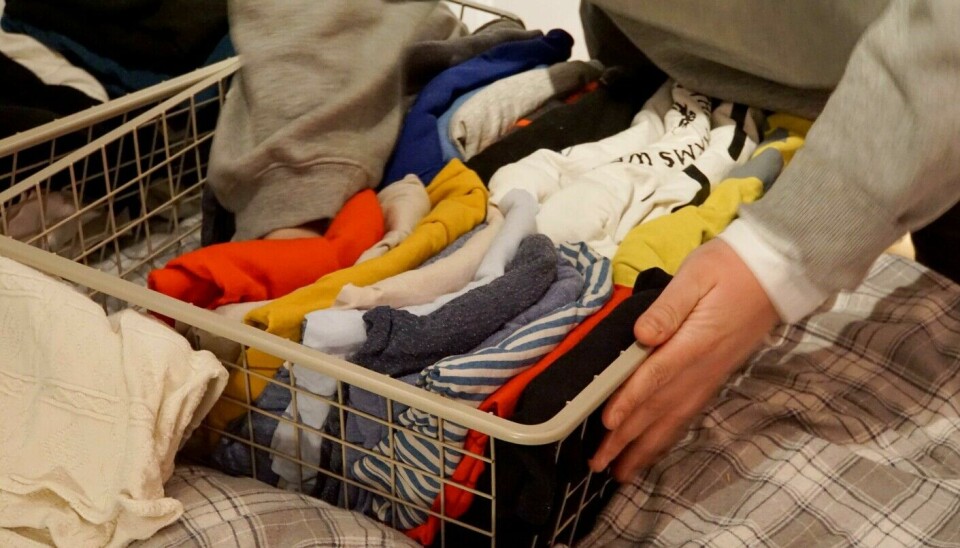
Do you have more or less clothes in your closet than the average Norwegian?
Norwegians have an average of just over 350 items in their wardrobe. But having lots of clothes is not necessarily problematic, researchers say.
Counting around 200 items of clothing takes about half an hour. Researcher Vilde Haugrønning knows this, because she has been to the homes of 15 couples and counted all their clothes.
They each had on average about 378 garments in their closets.
This is in good agreement with a figure from 2016 (link in Norwegian), where the average number of clothes in Norwegian wardrobes was 359.
“I interpret that to mean that most people have between 200 and 400 items of clothing in their wardrobe,” Haugrønning says. "At any rate, there are few who have fewer than 200 garments."
There are also many people who have more than 400 items of clothing, according to the clothing researcher. Most are women.
“My figures show women on average had twice as much clothes as men, based on my count of 30 people’s clothing,” she says.
The study in which these figures are included has not yet been published.
An awful lot of clothes
Haugrønning's research is part of a project called Change, at Consumption Research Norway (SIFO) at the Oslo Metropolitan University (OsloMet). The goal of the project is a ‘green transition in clothing consumption’.
We all have an awful lot of clothes. Or perhaps more importantly: enormous amounts of clothing are produced daily, much more than what we need.
Most viewed
No content
According to a report from Economics Norway (link in Norwegian), an independent analytical group, the clothing industry in Norway disposed of at least 825 tonnes of unsold clothes in 2021.
“We are talking about a doubling of imported clothing in the last 20 years,” Ingun Grimstad Klepp, a professor at OsloMet and project manager for Change, says.
“The problem is that we don’t wear out our clothes. We don’t wear them out and we throw usable clothes in the trash. We need to stop the import of clothing, but that is partly dependent on sales,” she says.
100 pairs of socks
But back to the closet.
Because how much clothing is too much clothing?
“People’s feeling that they had too many clothes was strong, regardless of the number. Both people who had just over 200 articles of clothing and those who had close to 500 garments said they had too much,” Haugrønning says.
And putting a number on the contents of your own closet in advance is impossible. Socks were the item of clothing where most people were surprised by how many they actually had.
“We don't think of clothes in numbers, and you rarely see your entire wardrobe. So it can be weird to realise that you actually have 100 pairs of socks in your closet,” Haugrønning says.
Several of the participants found clothes they had forgotten about or didn't know where were, which they then begain using again.

Tidy up to wear out
And that’s a good thing, according to the SIFO clothing researchers. Because having a lot of clothes is not in itself stupid. And getting rid of clothes is not necessarily a goal.
“This is about why, and how your wardrobe has become large,” Haugrønning says. “If it’s large because you buy a lot, but also throw a lot away, then that’s not good for the environment. But if it's because you rarely throw things away and have lived a longer life, then it can be good.”
A large wardrobe can mean that you take care of things, that you have what you need for different occasions and seasons, and that you wear out your clothes.
So even though she has spent time counting T-shirts and sweaters and trousers in other people's wardrobes, Haugrønning does not want to focus too much on these numbers.
“The focus should rather be on how often you buy clothes, and how often you throw them away. But you shouldn’t think that just by cleaning out your closet you can get a clearer conscience. We don't have good enough solutions today for where the clothes we get rid of end up,” she says.
And that is precisely why the 15 couples were visited again six months after the count, to go through what they had gotten rid of since last time.

“Once this data has been analysed, I will be able to say something about the environmental impact of the individual wardrobe,” she says.
It’s also not so smart to get rid of your clothes too soon, according to Haugrønning.
“They may come in handy again a couple of years later,” she says.
Your body and clothes
Clothes pose a difficult problem for many people, Haugrønning says.
“It has to do with your body. Your body changes, and you notice it in your clothes. And these changes are linked to life phases,” she says.
Through her studies, she finds that many people want to be good about their clothing consumption, and with to make environmentally friendly choices. They don't want too many clothes, and they wish things were a bit simpler when it comes to clothes.
But then there are weddings and confirmations, there’s exercise, work conferences, parents' meetings, and trips.
“It takes a lot of work to look for clothes, try on clothes, change clothes, and return clothes. And if you buy used, it also takes a lot of time and work,” Haugrønning says.
A clear piece of advice from the researchers is to spend some time shopping for clothes, so that you are sure that the clothes you buy actually fit well. You should also have a good overview of the clothes you own, so it is easy to put together outfits, for everyday life and special occasions.
“It’s important to recognise that it takes a lot of time to purchase and manage your clothing,” she says.
Women and clothes
The fact that there is a difference in how many clothes men and women have in their wardrobe is perhaps not surprising. But the reason behind this is so is not simply that women shop more.
“Both men and women in my study talked about their bodies. Both sexes gain and lose weight, which leaves you with clothes that can't be used. But women can get pregnant and undergo greater physical changes than men,” Haugrønning says.
“In this case, you often end up holding on to more clothes, because you think that you can use them when you are no longer pregnant, and you save maternity clothes for the next time you are pregnant. Women need more clothes because their bodies vary more in size,” she says.
And then there are the social differences.
Haugrønning finds clothes in men’s wardrobes that are old and worn, but which are nevertheless taken care of and used from time to time.
“But they are so worn that if they had belonged to the woman in the household, they would have been thrown away. It is not as acceptable for women to wear shabby clothes. There are expectations that govern what feels good and which have a lot to say about what clothes you end up having in your wardrobe,” she says.
Can't wait for a change in consumption
Haugrønning says it has taken a long time for research on clothing consumption to be taken seriously.
“There has been much less research on clothes than on food, for example,” she points out.
And when clothes have been studied, it’s often about fashion and identity, not the trousers and sweaters of everyday life. But it's the latter that is needed if we are to know where we can make an effort to create change, according to the researchers.
At the same time, neither Haugrønning nor Klepp believe that the individual consumer is the solution to the problem of extreme overproduction of clothing.
“This change will not happen quickly enough. We are facing challenges that mean we have to act quickly. The time has now come for regulations, and what we need to do is to regulate imports," Klepp says.
The good news is that we can reduce imports to a third or a quarter of today's without affecting our use of clothing.
"Our purchase of new clothes will have to decrease, but we can still be just as beautiful, well-dressed, and warm as we are today. We were no less satisfied 20 years ago, when we used around half the resources we use today," she says.
Strong commercial forces
Synnøve Rubach is a senior researcher at NORSUS, the Norwegian Institute for Sustainability Research. Her latest report was launched at Arendalsuka, an annual political event in Norway, with fresh figures for how much clothing is imported to Norway. This totals to a staggering 90,000 tonnes a year (link in Norwegian).
Rubach agrees that imports must be reduced, but she is not sure how quickly this can be done.
“There are strong commercial forces at work here. Our data is incomplete. For example, we do not have an overview of how much clothing is actually sold, because businesses won’t answer us, and it isn't mandatory for them to report these numbers,” she says.
The report on imported clothing forms part of the basis for creating an arrangement where clothing manufacturers and importers take more responsibility, with the aim of curbing imports. But this is not the ultimate solution, according to Rubach.
“It's merely a fee for handling a waste management system, but it will be a step in the right direction,” she says.
Doing something about each individual's consumption is very important, Rubach believes. Studies of the type Haugrønning is doing are extremely important in this respect.
“We need more of these kinds of studies, which look at different parts of Norway, different population groups, and income groups. We need to gain more insight, so that we can adapt nudging methods, small nudges in everyday life that get people to switch to more responsible consumption,” Rubach says.
“Only one per cent of the clothes that are collected in Norway are reused here at home. There are enough clothes, so to speak, that we're almost drowning in them. But people want new things all the time. We must change our consumption so that used clothes are also usable,” she says.
———
Translated by Nancy Bazilchuk
Read the Norwegian version of this article on forskning.no

































